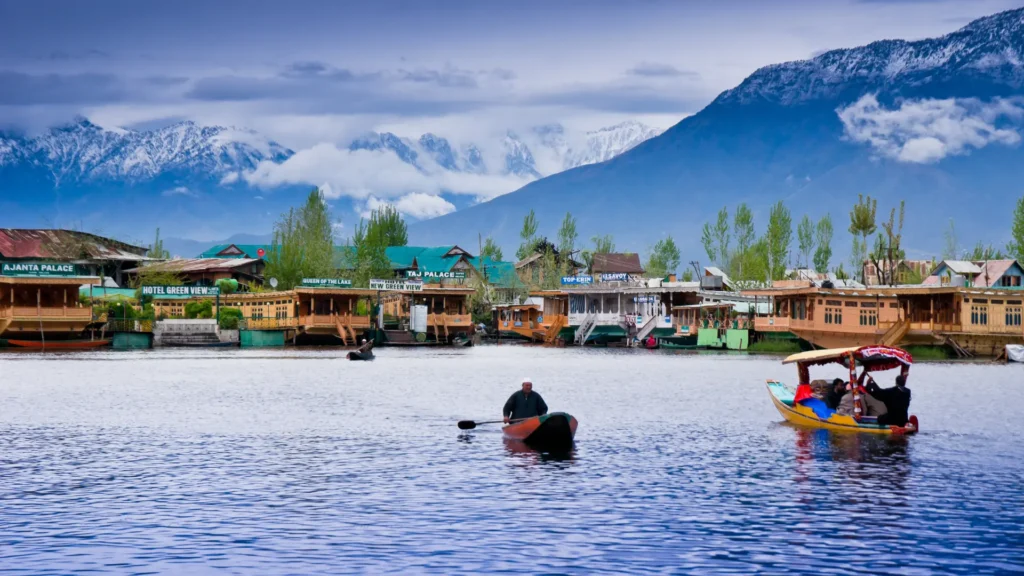Kashmir

Kashmir: A Paradise on Earth
Nestled in the northernmost part of India, Kashmir has long been described as “Paradise on Earth,” and with good reason. From snow-capped mountains to lush green meadows, and sparkling lakes to vibrant gardens, the region is a breathtaking blend of natural beauty, cultural richness, and spiritual serenity. A destination of dreams, Kashmir is not only a visual delight but also a land of history, heritage, and hospitality. This blog takes you on a journey through the many facets of Kashmir—its nature, culture, cuisine, and more.
The Scenic Beauty
Kashmir is a canvas painted with the most vivid and soothing colors of nature. The towering Himalayas form a majestic backdrop, while valleys like Gulmarg, Sonmarg, and Pahalgam offer stunning vistas that change with every season. The famous Dal Lake in Srinagar is a serene expanse of water, dotted with traditional houseboats and shikaras (wooden boats), where life moves at a slow, graceful pace.
In spring and summer, tulip gardens bloom in riotous color, attracting Kashmir tourists from all over the world. In winter, the region transforms into a snowy wonderland, attracting adventure enthusiasts for skiing, snowboarding, and other snow sports. The seasonal transformations of Kashmir make it a year-round destination, each visit offering something unique and unforgettable.
Cultural Heritage
Kashmir’s culture is as rich as its landscapes. Influenced by centuries of Persian, Central Asian, and Indian civilizations, it reflects a harmonious blend of traditions. The people of Kashmir, known for their warmth and hospitality, speak Kashmiri and Urdu, and practice customs deeply rooted in both Islamic and Hindu traditions.
One of the most prominent features of Kashmiri culture is its art and handicrafts. The region is world-famous for its exquisite Pashmina shawls, hand-knotted carpets, papier-mâché crafts, and intricate wood carvings. These art forms are not just products but representations of the Kashmiri soul, passed down through generations.
Music and dance, particularly the Rouf (a traditional dance performed by women), are intrinsic to festive celebrations, while Sufi music plays a vital role in the spiritual life of the people.
Spiritual Sanctity
Kashmir is not only a treat for the eyes but also a balm for the soul. The valley has been a center of spirituality for centuries. It is home to important religious sites for both Hindus and Muslims. The Amarnath Cave, one of the holiest shrines in Hinduism, attracts thousands of pilgrims each year who trek through the Himalayas to reach the ice Shiva Lingam. Similarly, the Hazratbal Shrine, located on the banks of Dal Lake, is a revered place of worship for Muslims.
Temples like Shankaracharya and ancient monasteries in the nearby region of Ladakh (part of the larger Jammu & Kashmir territory) further highlight the spiritual depth and diversity of the region.
The Cuisine of Kashmir
No visit to Kashmir is complete without indulging in its rich and flavorful cuisine. Kashmiri food is a feast of spices and aromas, with influences from Persian and Central Asian cuisines. The famous Wazwan, a multi-course meal predominantly non-vegetarian, is a symbol of Kashmiri hospitality and culinary excellence. It includes dishes like Rogan Josh (a lamb curry), Gustaba (meatballs in yogurt gravy), and Yakhni (yogurt-based mutton curry).
For vegetarians, dishes like Dum Aloo (spiced potatoes), Nadru Yakhni (lotus stem in yogurt gravy), and Haak (collard greens) offer a unique taste of the valley’s flavors. The traditional noon chai (salted pink tea) and kahwa (a green tea infused with saffron, almonds, and cinnamon) are perfect beverages to enjoy while soaking in the views.
Adventure and Activities
Kashmir isn’t just about relaxation and sightseeing; it’s also a hub for adventure tourism. The mountains provide excellent opportunities for trekking, mountaineering, and skiing. Gulmarg, known as the “Meadow of Flowers,” becomes a snowy haven for winter sports enthusiasts and is home to one of the highest gondola rides in the world.
Trekking routes to places like Tarsar Lake, Gangbal, and the Great Lakes of Kashmir offer experiences that blend physical challenge with breathtaking beauty. River rafting in the Lidder River and camping in remote valleys provide thrilling alternatives to the usual tourist trail.

Political History and Challenges
While the natural and cultural beauty of Kashmir is unparalleled, it’s impossible to talk about the region without acknowledging its complex political history. Since the partition of India in 1947, Kashmir has been at the center of a territorial dispute between India and Pakistan, leading to conflict, unrest, and periods of violence.
Despite these challenges, the spirit of Kashmir and its people remains unbroken. Tourism has rebounded in recent years, and efforts are being made to promote peace, development, and cultural exchange. Travelers are advised to check local conditions before visiting but should not let political concerns overshadow the valley’s immense offerings.
Conclusion: The Eternal Allure of Kashmir
Kashmir is more than a destination—it’s an emotion, an experience that lingers in the heart long after the journey ends. From the soothing silence of snow-covered valleys to the buzz of local markets, from the spiritual calm of shrines to the sensory delight of its cuisine, Kashmir is a world within a world.
To visit Kashmir is to witness the resilience of nature and humanity alike. It is a place where every sunrise feels poetic, and every interaction is filled with warmth. Whether you’re a nature lover, a history buff, a foodie, or a spiritual seeker, Kashmir welcomes you with open arms.
In the words of Mughal emperor Jahangir, “If there is a paradise on earth, it is this, it is this, it is this.”
